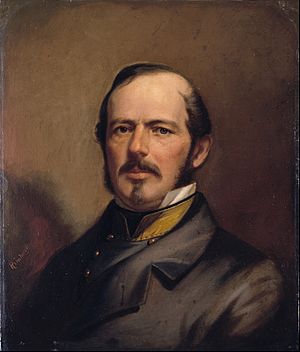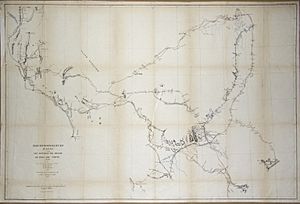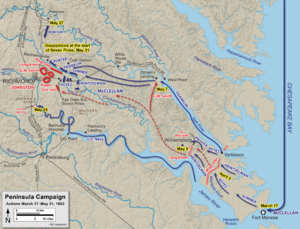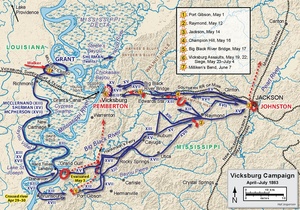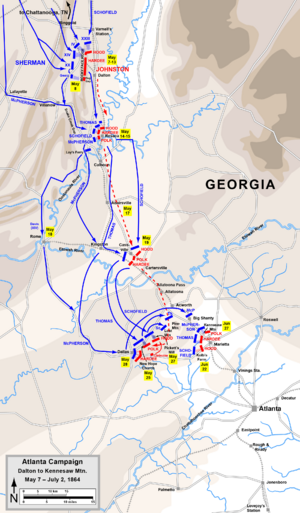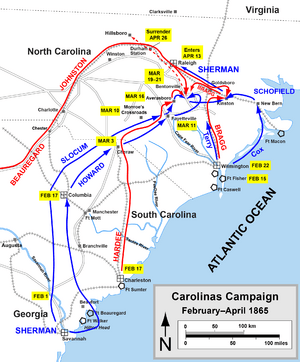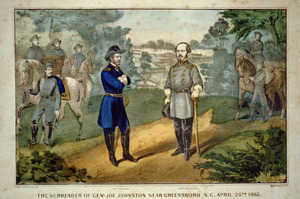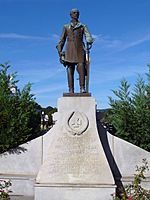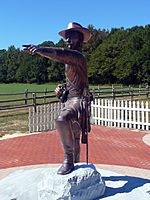Joseph E. Johnston facts for kids
Quick facts for kids
Joseph E. Johnston
|
|
|---|---|
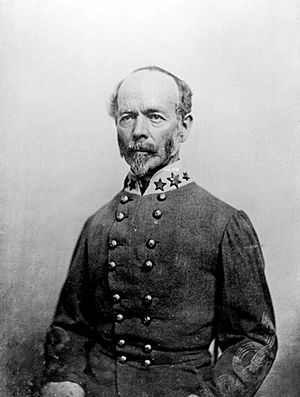
Johnston in uniform, c. 1862
|
|
| Birth name | Joseph Eggleston Johnston |
| Nickname(s) | Joe |
| Born | February 3, 1807 Farmville, Virginia, U.S. |
| Died | March 21, 1891 (aged 84) Washington, D.C., U.S. |
| Buried |
Green Mount Cemetery,
Baltimore, Maryland, U.S. |
| Allegiance |
|
| Service/ |
|
| Years of service |
|
| Rank |
|
| Commands held |
|
| Battles/wars | |
| Alma mater | United States Military Academy |
| Signature | |
| Member of the U.S. House of Representatives from Virginia's 3rd district |
|
| In office 1879–1881 |
|
| Preceded by | Gilbert Carlton Walker |
| Succeeded by | George D. Wise |
Joseph Eggleston Johnston (February 3, 1807 – March 21, 1891) was an American army officer. He served with honor in the United States Army during the Mexican–American War and the Seminole Wars. When his home state, Virginia, left the United States, he joined the Confederate States Army. He became one of its most important generals.
Johnston studied to be an engineer at the United States Military Academy at West Point, New York. He graduated in the same class as Robert E. Lee. Before the Civil War, he was a brigadier general in the U.S. Army.
During the American Civil War, Johnston often disagreed with Confederate president Jefferson Davis. He did not win many of the battles he led. He was a senior commander at the First Battle of Bull Run in 1861. But the victory is often given to his helper, P.G.T. Beauregard. Johnston defended Richmond, Virginia, in 1862 during the Peninsula Campaign. He had to pull back because U.S. General George B. McClellan had more soldiers. Johnston was badly hurt at the Battle of Seven Pines and was replaced by Robert E. Lee.
Later in the war, Johnston led the Army of Tennessee against U.S. General William Tecumseh Sherman. This was during the Atlanta Campaign. Near the end of the war, Johnston was put back in charge of the remaining forces in the Carolinas Campaign. After the war, U.S. Generals Ulysses S. Grant and Sherman praised Johnston. They even became friends with him.
After the war, Johnston worked in railroads and insurance. He was elected to the United States House of Representatives for one term. He later died from pneumonia after attending Sherman's funeral in the rain.
Contents
Early Life and Education
Joseph Johnston was born on February 3, 1807, in Virginia. His family lived near Farmville, Virginia. His grandfather came to Virginia from Scotland in 1726. Joseph was the seventh son of Judge Peter Johnston Jr. and Mary Valentine Wood. His mother was the niece of Patrick Henry, a famous American leader. Joseph was named after Major Joseph Eggleston, who served with his father in the American Revolutionary War.
In 1811, his family moved to Abingdon, Virginia. Joseph went to the United States Military Academy at West Point. He was nominated by John C. Calhoun, who was the Secretary of War. Johnston did well in his studies. He graduated in 1829, ranking 13th out of 46 cadets. He became a second lieutenant in the U.S. Army. He was the first West Point graduate to become a general in the regular army. He reached a higher rank in the U.S. Army than Robert E. Lee, who was in his class.
Service in the U.S. Army
Johnston left the Army in 1837 to study engineering. But he rejoined in 1838. This was after he was involved in a fight during the Second Seminole War in Florida. He was a civilian engineer at the time. He said his clothes had "no less than 30 bullet holes." One bullet even grazed his head, leaving a scar. He decided to go back to the Army because he saw more action as a civilian.
On July 10, 1845, Johnston married Lydia Mulligan Sims McLane in Baltimore. Her father, Louis McLane, was a very important politician. He was a congressman, senator, and ambassador. Johnston and Lydia did not have any children.
Johnston was excited when the Mexican–American War started. He served with Lt. Gen. Winfield Scott. He was hurt badly by a cannonball during the Battle of Cerro Gordo. He was promoted for his bravery there. After he got better, he rejoined the army. He was hurt again at the Battle of Chapultepec. Winfield Scott joked that Johnston "had an unfortunate knack of getting himself shot in nearly every engagement."
In the 1850s, Johnston wanted to get his higher wartime rank back. But Secretary of War Jefferson Davis said no. Despite this, Davis appointed him lieutenant colonel in the 1st U.S. Cavalry in 1855. Johnston worked with Captain George B. McClellan, who would later lead the U.S. Army against him.
In 1860, Johnston was promoted to brigadier general. He became the Quartermaster General of the U.S. Army. He did not like this job because he preferred leading soldiers in the field.
Civil War Service
First Battle of Bull Run
When Virginia left the United States in 1861, Johnston resigned from the U.S. Army. He was the highest-ranking U.S. Army officer to do so. He said he believed in the right of states to choose their own path. He wanted to defend his home state and family.
He first became a major general in the Virginia militia. But then he joined the Confederate States Army as a brigadier general. He took command of the Confederate Army of the Shenandoah.
At the First Battle of Bull Run in July 1861, Johnston quickly moved his army to help Brig. Gen. P. G. T. Beauregard. Johnston let Beauregard plan the battle because he knew the area better. Johnston saw that the main fighting was happening at Henry House Hill. He rode to the front and helped rally his soldiers. He encouraged Brig. Gen. Barnard Elliott Bee, Jr., whose words inspired the famous nickname "Stonewall Jackson." Johnston's actions behind the scenes were very important for the Confederate victory. After the battle, Johnston helped design the Confederate Battle Flag. It was his idea to make the flag square.
Disagreements with President Davis
In August, Johnston was promoted to full general. This is like a four-star general today. But he was upset because three other generals he used to outrank were now ranked above him. This included Samuel Cooper, Albert Sidney Johnston, and Robert E. Lee. Only Beauregard was ranked below him. This caused a lot of bad feelings between Johnston and President Jefferson Davis. This disagreement lasted throughout the war. Davis argued that Johnston's U.S. Army rank was for a staff job, not a combat role.
Johnston was put in charge of the Department of the Potomac. In the winter of 1861–62, his army stayed quiet. The U.S. Army, led by George B. McClellan, was getting ready. McClellan thought Johnston's defenses were very strong. In March, Johnston moved his army back. President Davis was surprised and unhappy about this move. Davis then brought Robert E. Lee to Richmond as his military advisor.
Peninsula Campaign
In April 1862, McClellan's army landed in Virginia and slowly moved toward Yorktown. Johnston wanted to defend Richmond by focusing on strong defenses around the city. But he was not able to convince Davis. So, he put most of his army on the Peninsula. After a long siege by McClellan, Johnston pulled back. He fought battles at Williamsburg and Eltham's Landing. By late May, the U.S. Army was very close to Richmond.
Johnston knew he could not defend Richmond forever from McClellan's large army. He saw that McClellan's army was split by the Chickahominy River. So, Johnston attacked on May 31 in the Battle of Seven Pines. His plan was daring, but his officers did not carry it out correctly. The battle did not have a clear winner, but it stopped McClellan's advance. Johnston was badly wounded in his shoulder and chest during the battle. He was replaced by Robert E. Lee, who then led the Army of Northern Virginia for the rest of the war.
Vicksburg Campaign
Johnston was discharged from the hospital in November 1862. He was given command of the Department of the West. This meant he was in charge of Gen. Braxton Bragg's army and Lt. Gen. John C. Pemberton's forces.
The main problem for Johnston in the West was defending Vicksburg, Mississippi. U.S. General Ulysses S. Grant was trying to capture it. In April 1863, Grant's army crossed the Mississippi River. They surprised Pemberton's forces. On May 9, Johnston was ordered to go to Mississippi and take command. He arrived in Jackson on May 13. He found that two U.S. Army groups were moving on the city. He only had 6,000 soldiers. Johnston ordered his troops to leave Jackson after a fight. Grant captured Jackson and then moved toward Vicksburg.
Johnston tried to join Pemberton's forces, but Pemberton was defeated at Champion Hill. Pemberton's soldiers retreated into Vicksburg's defenses. Johnston told Pemberton to leave the city and join him. But Davis had ordered Pemberton to defend Vicksburg. Grant then began a siege. The soldiers and people inside Vicksburg waited for Johnston to rescue them. But Johnston felt he needed more soldiers before he could attack. Pemberton's army surrendered on July 4, 1863. This loss gave the United States control of the Mississippi River.
Johnston and Davis blamed each other for the loss of Vicksburg. Davis thought about firing Johnston. But Johnston was popular and had many friends in Richmond. Instead, Bragg's army was taken out of Johnston's command. This left Johnston in charge of only Alabama and Mississippi.
Atlanta Campaign
In the spring of 1864, U.S. Maj. Gen. William T. Sherman advanced from Chattanooga toward Atlanta. Johnston used a strategy of pulling back and setting up strong defenses. Sherman would then move around his defenses, forcing Johnston to retreat again. Johnston wanted to keep his army safe. He slowed the U.S. advance and caused more losses to Sherman's army than his own.
Sherman began his Atlanta Campaign on May 4. Johnston's army fought defensive battles. He retreated from Dalton and then from Resaca. Johnston tried to attack at Cassville, but an unexpected enemy force appeared. He stopped his attack and retreated again. In June, Sherman's forces continued to move around Atlanta. Johnston strongly pushed back Sherman's direct attack at the Battle of Kennesaw Mountain.
However, U.S. forces were getting very close to Atlanta. Johnston had given up over 110 miles of land in two months. The Confederate government was very worried. When Johnston retreated across the Chattahoochee River, the last major barrier before Atlanta, President Davis lost patience.
In July, Davis sent Gen. Braxton Bragg to Atlanta. After Bragg talked to local leaders and Johnston's officers, he told Davis to replace Johnston. Davis removed Johnston from command on July 17, 1864. Johnston's replacement, Lt. Gen. John Bell Hood, was left in a very difficult situation. Hood was forced to abandon Atlanta in September. Davis's decision to remove Johnston was one of the most debated actions of the war.
North Carolina and Surrender
Johnston went to Columbia, South Carolina, and was mostly retired. But as the Confederacy worried about Sherman's March to the Sea through Georgia and the Carolinas, people wanted Johnston back. In January 1865, Congress gave Robert E. Lee more power and suggested Johnston be put back in command. Lee recommended Johnston to Davis.
Despite his doubts, Davis put Johnston back in charge on February 25, 1865. His new command included forces in North Carolina, South Carolina, Georgia, and Florida. These armies were very small and lacked supplies. Johnston hoped to combine his forces with a part of Robert E. Lee's army. They would try to defeat Sherman and then return to Virginia.
On March 19, 1865, Johnston surprised part of Sherman's army at the Battle of Bentonville. He had some success, but Sherman's larger numbers forced him to retreat. Johnston's army withdrew to Greensboro.
After learning that Lee had surrendered at Appomattox Court House, Johnston met with General Sherman. They met at a small farm called Bennett Place in North Carolina. After three days of talks, Johnston surrendered his army and all remaining Confederate forces in the Carolinas, Georgia, and Florida. This was the largest surrender of the war, with 89,270 soldiers. Johnston was released on May 2.
After the surrender, Sherman gave food to the hungry Confederate soldiers. He also gave them horses and mules to help them farm. Johnston never forgot Sherman's kindness. He wrote to Sherman that it made him feel better about having to fight him.
Later Life
After the war, Johnston worked to support himself and his wife. He became president of a small railroad company. He also started an insurance agency in Savannah, Georgia.
Johnston wrote his memoirs, Narrative of Military Operations (1874). In his book, he was very critical of Davis and some other generals. He complained again about his rank in the Confederate Army. He tried to explain his cautious way of fighting. His book did not sell well.
Even though many Confederate generals criticized Johnston, Sherman and Grant wrote good things about him in their own memoirs. Sherman called him a "dangerous and wily opponent." Grant supported Johnston's choices in the Vicksburg Campaign.
Johnston moved to Richmond in 1876. He served in the United States House of Representatives from 1879 to 1881 as a Democrat. He did not run for reelection. He was later appointed as a commissioner of railroads by President Grover Cleveland.
After his wife died in 1887, Johnston often went to meetings for veterans. He was always cheered there. When General Sherman died, Johnston was an honorary pallbearer at his funeral. During the procession in New York City in February 1891, it was cold and rainy. But Johnston kept his hat off as a sign of respect. Someone asked him to put on his hat, but Johnston replied, "If I were in his place, and he were standing here in mine, he would not put on his hat." He caught a cold that day, which turned into pneumonia. Johnston died ten days later in Washington, D.C. He was buried next to his wife in Green Mount Cemetery, Baltimore, Maryland.
Legacy and Honors
Johnston's writings are kept at the College of William & Mary.
-
Johnston statue in Dalton, Georgia, where he took command of the Army of Tennessee
-
Johnston statue at the location of the Battle of Bentonville, in North Carolina
- A public statue of Johnston was put up in Dalton, Georgia, in 1912.
- On March 20, 2010, a bronze statue of Johnston was dedicated at the site of the Battle of Bentonville in North Carolina.
- During World War II, the United States Navy named a Liberty Ship after Johnston.
See also
 In Spanish: Joseph E. Johnston para niños
In Spanish: Joseph E. Johnston para niños


